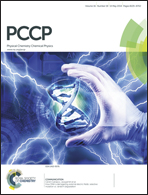Interaction of a potential chloride channel blocker with a model transport protein: a spectroscopic and molecular docking investigation
Abstract
The present work demonstrates a detailed characterization of the interaction of a potential chloride channel blocker, 9-methyl anthroate (9-MA), with a model transport protein, Bovine Serum Albumin (BSA). The modulated photophysical properties of the emissive drug molecule within the microheterogeneous bio-environment of the protein have been exploited spectroscopically to monitor the probe–protein binding interaction. Apart from evaluating the binding constant, the probable location of the neutral molecule within the protein cavity (subdomain IB) is explored by an AutoDock-based blind docking simulation. The absence of the Red-Edge Effect has been corroborated by the enhanced lifetime of the probe, being substantially greater than the solvent reorientation time. A dip-and-rise characteristic of the rotational relaxation profile of the drug within the protein has been argued to originate from a significant difference in the lifetime as well as amplitude of the free and protein-bound drug molecule. Unfolding of the protein in the presence of the drug molecule has been probed by the decrease of the α-helical content, obtained via circular dichroism (CD) spectroscopy, which is also supported by the gradual loss of the esterase activity of the protein in the presence of the drug molecule.


 Please wait while we load your content...
Please wait while we load your content...